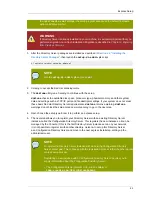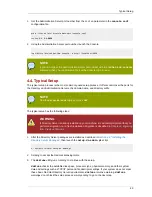
Typical Setup
43
1. Get the Administration Server port number from the
Listen
parameter in the
console.conf
configuration file.
grep \^Listen /etc/dirsrv/admin-serv/console.conf
Listen 0.0.0.0:
9830
2. Using the Administration Server port number, launch the Console.
/opt/dirsrv/bin/redhat-idm-console -a http://localhost:9830
NOTE
If you do not pass the Administration Server port number with the
redhat-idm-console
command, then you are prompted for it at the Console login screen.
4.4. Typical Setup
The typical setup process is the most commonly-used setup process. It offers control over the ports for
the Directory and Administration Servers, the domain name, and directory suffix.
NOTE
Run the
setup-ds-admin.pl
script as
root
.
The typical setup has the following steps:
WARNING
If Directory Server is already installed on your machine, it is extremely important that you
perform a migration, not a fresh installation. Migration is described in
Chapter 8, Migrating
from Previous Versions
.
1. After the Directory Server packages are installed as described in
Section 4.2, “Installing the
Directory Server Packages”
, then launch the
setup-ds-admin.pl
script.
# /opt/dirsrv/sbin/setup-ds-admin.pl
2. Select
y
to accept the Red Hat licensing terms.
3. The
dsktune
utility runs. Select
y
to continue with the setup.
dsktune
checks the available disk space, processor type, physical memory, and other system
data and settings such as TCP/IP ports and file descriptor settings. If your system does not meet
these basic Red Hat Directory Server requirements,
dsktune
returns a warning.
dsktune
warnings do not block the setup process; simply enter
y
to go to the next step.






























